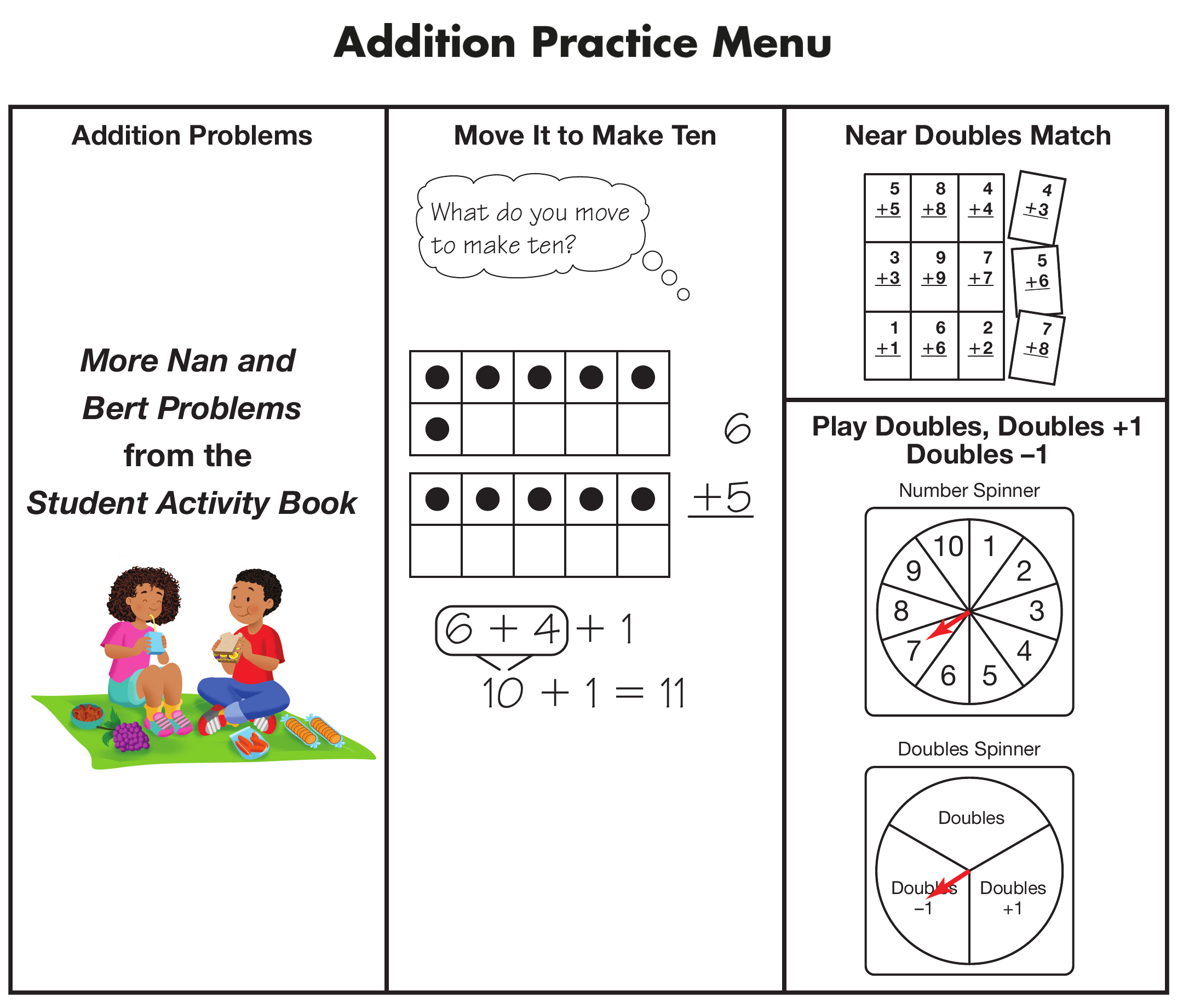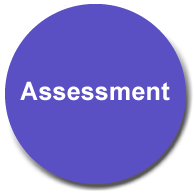Assessment in this unit
Key Ideas, Expectations, and Opportunities
Using Assessment to Meet Individual Needs
The explicit Expectations and assessment tasks in this unit describe what it means to “get it.” Providing feedback
on these Expectations helps identify students who need to access the content another way, need further
practice opportunities, or are ready to extend or deepen their understanding of a concept. Instructional opportunities
that help support the varied needs of students also need to be identified. These opportunities provide
models that can be replicated or used multiple times and can be used in a variety of settings (e.g., home, transitions,
support classroom, as a center).
The Assessment Program serves the
following purposes:
- It provides information to teachers about what students know and can do. This information is used to guide instruction. An activity may help teachers answer questions about whole-class instruction: What do I do next? In the next minute? Next lesson? Next class? Next unit? Other assessments may help teachers decide how to support individual students, including those who struggle with a concept and those who are ready to be challenged.
- It communicates the goals of instruction to parents and students. What teachers choose to assess communicates to the class what they value. For example, if teachers want students to work hard at communicating problem-solving strategies, then it is important to assess mathematical communication.
- It provides feedback to students and parents about student progress. This includes teacher evaluation of student progress as well as students' assessment of their own progress.
Key Mathematical Ideas
The mathematical content in Math Trailblazers is organized around a set of Key Ideas. These Key Ideas are
based on the National Council of Teachers of Mathematics (NCTM) Standards for the grade band as well as
current thinking in the mathematics education community, e.g., Charles (2005), NCTM (2000), Van de Walle
(2005). There is a set of Key Ideas for each content strand: Number, Algebra, Geometry, Measurement, and
Data. They are based on "big ideas" in mathematics and describe what students should be able to do within
each strand. The Key Ideas are shown in the table in Figure 1.
| 1. Number Sense: Understand the base-ten number system, recognize relationships among quantities and numbers, and represent numbers in multiple ways. |
2. Operations: Understand the meaning of numerical operations and their application for solving problems. |
3. Computation and Estimation: Use efficient and flexible procedures to compute accurately and make reasonable estimates. |
|
| 1. Identifying Patterns: Identify and describe patterns and relationships, including how a change in one variable relates to a change in a second variable. |
2. Tables and Graphs: Represent patterns and relationships with graphs, tables, and diagrams. |
3. Symbols: Represent patterns and relationships with symbols (includes using variables in formulas and as unknowns in equations). |
4. Using Patterns: Apply relationships, properties, and patterns to solve problems, develop generalizations, or make predictions. |
| 1. Shapes: Identify, describe, classify, and analyze 2- and 3-dimensional shapes based on their properties. |
2. Orientation and Location: Use coordinate systems to specify locations and describe spatial relationships. |
3. Motion: Apply transformations (slides, flips, and turns) and use symmetry to analyze mathematical situations. |
4. Geometric Reasoning: Use visualization, spatial reasoning, and geometric modeling to solve problems. |
| 1. Measurement Concepts: Understand measurable attributes of objects or situations (length, area, mass, volume, size, time) and the units, systems, and processes of measurement. |
2. Measurement Skills: Use measurement tools, appropriate techniques, and formulas to determine measurements. |
| 1. Data Collection: Select, collect, and organize data to answer questions, solve problems, and make predictions. |
2. Data Representation: Select and create appropriate representations, including tables and graphs, for organizing, displaying, and analyzing data. |
3. Data Description: Describe a data set by interpreting graphs, identifying patterns, and using statistical measures, e.g., average and range. |
4. Using Data: Apply relationships and patterns in data to solve problems, develop generalizations, and make predictions. |
Figure 1: Key Ideas for Math Trailblazers (Key Ideas addressed in Unit 12 are shaded.)
Expectations
To monitor students' growth across and within grades, there is a set of Expectations that describes what
students are “expected” to do within each content strand. Expectations show the growth of the mathematical
content within the Key Ideas for each strand.
| EXPECTATIONS |
|
Use this list of Expectations to assess students on the key concepts and skills in this unit. |
| E1 |
Represent doubles, near doubles, and halves using counters, pictures, and number sentences. |
| E2 |
Represent addition and subtraction using stories, drawings, diagrams, counters, number sentences, number lines, or ten frames. |
| E3 |
Solve word problems (e.g., join, separate/take away, part-whole, compare) involving two whole numbers whose sum is between 10 and 20. |
| E4 |
Recognize that the equal sign represents the relationship between two equal quantities. |
| E5* |
Use mental math strategies and reasoning strategies (e.g., using doubles, using ten, making ten) to solve addition problems with sums between 10 and 20 and the related subtraction problems. |
| E6* |
Use strategies that apply the proper ties of addition (e.g., turn-around, compose and decompose numbers) to solve addition and subtraction problems. |
| E7* |
Find the unknown whole number in an addition or subtraction equation relating three whole numbers. |
| E8* |
Demonstrate fluency with the addition facts in Group A (0 + 1, 1 + 1, 2 + 1, 3 + 1, 0 + 2, 2 + 2, 3 + 2, 4 + 2). |
| E9* |
Determine the unknown number in an addition or subtraction sentence relating three whole numbers for the facts in Group A. |
Targeted Practice
This unit provides opportunities for additional targeted practice for some of the Expectations. See the chart in Figure 3 and the descriptions that follow. These opportunities connect directly to assessment tasks so the practice can be tailored to the current level of student progress.
- For students who are struggling with the Expectation, practice is targeted toward the foundational concepts and skills involved and often provides a different way to access the content.
- For students who are making significant progress toward the Expectation, practice is designed to help move toward proficiency and autonomy.
- For students who are already meeting the Expectation, opportunities are provided to deepen or extend understanding.
| Expectation |
Opportunities for Targeted Practice |
| E1. |
Represent doubles, near doubles, and halves using counters, pictures, and number sentences. |
|
| E5.* |
Use mental math strategies and reasoning strategies (e.g., using doubles, using ten, making ten) to solve addition problems with sums between 10 and 20 and the related subtraction problems. |
|
| E6.* |
Use strategies that apply the properties of addition (e.g., turn-around, compose and decompose numbers) to solve addition and subtraction problems. |
|
| E7.* |
Find the unknown whole number in an addition or subtraction equation relating three whole numbers. |
|
| E8.* |
Demonstrate fluency with the addition facts in Group A (0 + 1, 1 + 1, 2 + 1,
3 + 1, 0 + 2, 2 + 2, 3 + 2, 4 + 2). |
|
| E9.* |
Determine the unknown number in an addition or subtraction sentence relating three whole numbers for the facts in Group A. |
|
* Denotes Benchmark Expectation |
Figure 3: Expectations for Unit 12 with opportunities for targeted practice
Games
There are three games in this unit that can be used to provide targeted practice. Games can be played in a center or used as part of class transitions, in another setting, or at home.
Activities
There is one activity in this unit that can be used to provide targeted practice. Activities can be placed in a center, used in other settings, or used at home.
Practice Menus
Many of the games and activities for targeted practice are consolidated in two different
Practice Menus. The menus of activities describe activities that revisit concepts developed earlier in the unit.
Based on students' assessment of their confidence with using mental math strategies to solve addition facts
between 10 and 20 [E5] and apply the properties of addition to add [E6], students select activities from a
Practice Menu. The first menu, the Addition Practice Menu, is in Lesson 7. See Figure 4. The second is the
Subtraction Practice Menu in Lesson 10. Teacher guidance can help students find the appropriate level of
practice based on evidence from earlier assessment tasks.

Figure 4: Addition Practice Menu from Lesson 7

















 ) on the Unit 12 Key Assessment Opportunities Chart. See Figure 2. In this unit, students will also get better acquainted with the Math Practices Expectations by discussing them in the context of a specific problem, receiving feedback, reviewing a peer's work, and revising their own work.
) on the Unit 12 Key Assessment Opportunities Chart. See Figure 2. In this unit, students will also get better acquainted with the Math Practices Expectations by discussing them in the context of a specific problem, receiving feedback, reviewing a peer's work, and revising their own work.